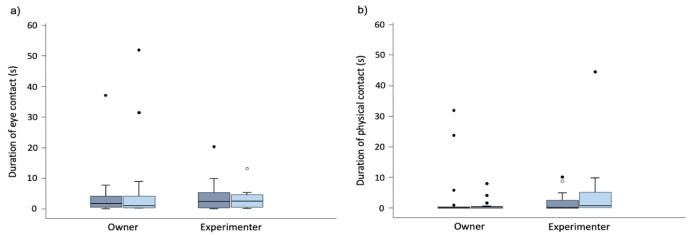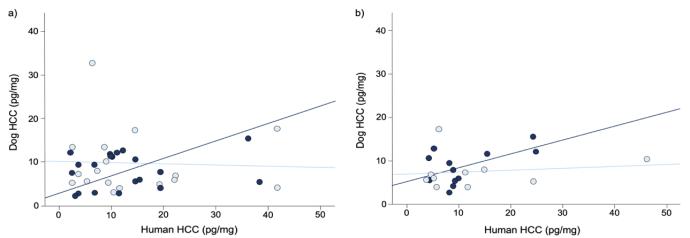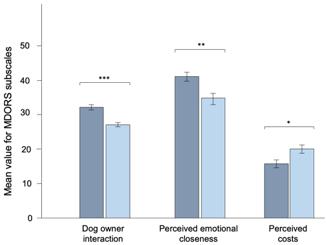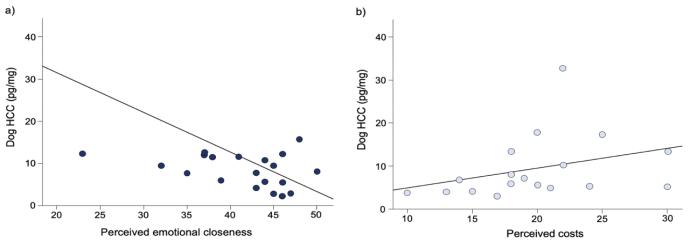Main findings
Unsolvable problem task
Eye contact
Three out of the 41 dogs participating in the unsolvable problem task did not gaze at either the experimenter or the owner during the observation time. All three dogs were breeds of ancient origin. Out of the 41 dogs, 18 did not engage in any physical contact with either the experimenter or the owner, 12 dogs of ancient origin and 6 dogs from the hunting group.
There were no significant differences between the breed groups for duration of eye contact with the owner or for duration of eye contact with the experimenter (Figure 1a; P > 0.05). No significant differences were found between breed groups for duration of physical contact with the owner or for duration of physical contact with the experimenter (Figure 1b; P > 0.05).
The two breed groups did not differ significantly in latency of gazing towards the owner (Mean; ancient 98.89 ±11.23 s, hunting 111.71 ± 15.00 s), experimenter (Mean; ancient 112.08 ± 11.87 s, hunting 90.89 ± 14.29 s) or human overall (Mean; ancient 86.06 ± 11.61 s; hunting 83.06 ± 13.68 s).

Proximity
A significant difference was found between breed groups regarding duration of being in proximity to the experimenter (Figure 2a; P = 0.025). Hunting breeds spent more time in proximity to the experimenter compared to dogs of ancient origin. Similarly, hunting dogs were found to have a significantly higher number of occasions spent in proximity to the experimenter (Figure 2b; P = 0.003). In addition, hunting dogs spent a significantly higher number of times in proximity to the setup (Figure 2b; P = 0.01) and elsewhere (Figure 2b; P = 0.009).

Long-term stress
The hair cortisol concentrations (HCCs) of ancient breeds correlated significantly positively with owner HCC (Figure 3a; P < 0.001) and a trend was found between ancient breeds and the extra adult person in the household (Figure 2b; P = 0.058). However, for hunting breeds there was no significant correlation between dog HCC and owner HCC (Figure 3a; P = 0.862) or between dogs and the extra adult person in the household (Figure 3b; P = 0.690). The age of the dog, owner sex or age did not significantly influence the cortisol levels (P > 0.05).

MDORS
All participating owners (N = 37) completed the questionnaire regarding their perceived relationship to their dogs. There was a significant difference between the breed groups for all three subscales of the MDORS; Dog-Owner Interaction, Perceived Emotional Closeness and Perceived Costs (Figure 4). The MDORS revealed that ancient breeds had a significantly higher score for Dog-owner interaction and Perceived emotional closeness while the hunting groups had a significantly higher score for Perceived costs.

MDORS & Long-term stress
Interestingly, ancient breeds HCCs tended to correlate with perceived emotional closeness (subscale II) of MDORS (Figure 5a; P = 0.062). And for hunting breeds, there was a significant positive correlation between dog HCC and perceived costs (subscale III) of MDORS (Figure 5b; P = 0.038).

Responsible for this page:
Director of undergraduate studies Biology
Last updated:
05/22/20
